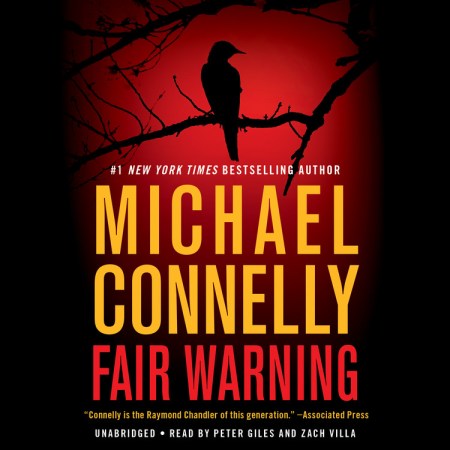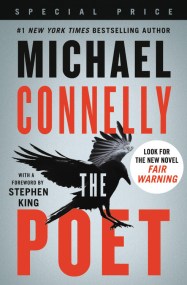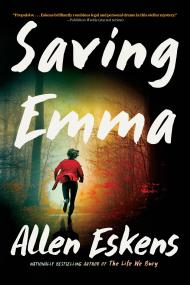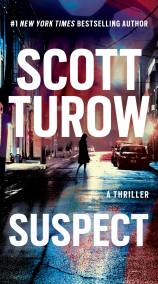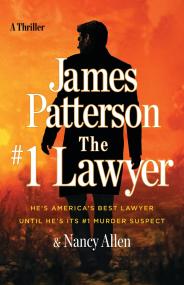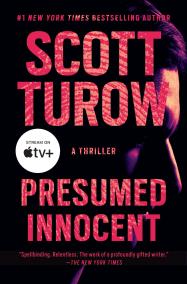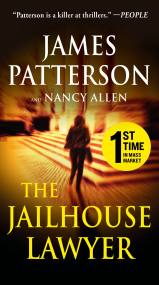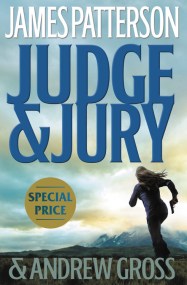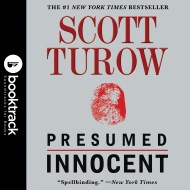Shopping Cart
Fair Warning
Description
Veteran reporter Jack McEvoy has taken down killers before, but when a woman he had a one-night stand with is murdered in a particularly brutal way, McEvoy realizes he might be facing a criminal mind unlike any he’s ever encountered.
Jack investigates—against the warnings of the police and his own editor—and makes a shocking discovery that connects the crime to other mysterious deaths across the country. Undetected by law enforcement, a vicious killer has been hunting women, using genetic data to select and stalk his targets.
Uncovering the murkiest corners of the dark web, Jack races to find and protect the last source who can lead him to his quarry. But the killer has already chosen his next target, and he’s ready to strike.
Terrifying and unputdownable, Fair Warning shows once again why “Michael Connelly has earned his place in the pantheon of great crime fiction writers” (Chicago Sun-Times).
A Kirkus Best Book of 2020
Michael Connelly and Jake Tapper: In Conversation
powered by CrowdcastWhat's Inside
1
I had called the story “The King of Con Artists.” At least that was my headline. I typed it up top but was pretty sure it would get changed because it would be an overstepping of my bounds as a reporter to turn a story in with a headline. The headlines and the decks below them were the purview of the editor and I could already hear Myron Levin chiding, “Does the editor rewrite your ledes or call up the subjects of your pieces to ask additional questions? No, he doesn’t. He stays in his lane and that means you need to stay in yours.”
Being that Myron was the editor he was speaking of in third person, it would be hard to come back with any sort of defense. But I sent the story in with the suggested headline anyway because it was perfect. The story was about the dark netherworld of the debt collection business—$600 million a year of it siphoned off in scams—and the rule at Fair Warning was to bring every fraud down to a face, either the predator’s or the prey’s, the victim or the victimizer. Make every story personal. And this time it was the predator. Arthur Hathaway, the King of Con Artists, was the best of the best. At sixty-two years old, he had worked every con imaginable in a life of crime centered in Los Angeles, from selling fake gold bars to setting up phony disaster-relief websites. Right now, he ran a racket convincing people they owed money that they didn’t really owe, and getting them to pay it. And he was so good at it that junior swindlers were paying him for lessons on Mondays and Wednesdays at a defunct acting studio in Van Nuys. I had infiltrated as one of his students and learned all I could. Now it was time to write the story and use Arthur to expose an industry that bilked millions and millions each year from everybody from little old ladies with dwindling bank accounts to young professionals already deep in the red with college loans. They all fell victim and sent their money because Arthur Hathaway convinced them to send it. And now he was teaching eleven future con men and one undercover reporter how to do it for fifty bucks a head twice a week. The swindler school itself might be his greatest con of all. The guy was truly a king with a psychopath’s complete lack of guilt. I also had reporting in the story on the victims whose bank accounts he had cleaned out and whose lives he had ruined.
Myron had already sold the story as a co-project to the Los Angeles Times, and that guaranteed it would be seen and the Los Angeles Police Department would have to take notice. King Arthur’s reign would soon be over and his roundtable of junior con men would be rounded up as well.
I read the story a final time and sent it to Myron, copying William Marchand, the attorney who reviewed all Fair Warning stories pro bono. We didn’t put anything up on the website that was not legally bulletproof. Fair Warning was a five-person operation if you counted the reporter in Washington, DC, who worked out of her home. One “wrong story” spawning a winning lawsuit or forced settlement would put us out of business, and then I’d be what I had been at least twice before in my career: a reporter with no place to go.
I got up from my cubby to tell Myron the story was finally in, but he was in his own cubby talking on the phone, and I could tell as I approached that he was on a fundraising call. Myron was founder, editor, reporter, and chief fundraiser for Fair Warning. It was an internet news site with no paywall. There was a donate button at the bottom page of every story and sometimes at the top, but Myron was always looking for the great white whale that would sponsor us and turn us from beggars into choosers—at least for a while.
“There really is no entity doing what we are doing—tough watchdog journalism for the consumer,” Myron told each prospective donor. “And with the current administration’s philosophy of deregulation and limiting oversight, there is nobody out there looking out for the little guy. Look, I get it, there are donations you could make that might give you a more visible bang for your buck. Twenty-five dollars a month keeps a kid fed and clothed in Appalachia. I get that. It makes you feel good. But you donate to Fair Warning, and what you are supporting is a team of reporters dedicated to—”
I heard “the pitch” several times a day, day in and day out. I also attended the Sunday salons where Myron and board members spoke to potential high-level donors, and I mingled with them afterward, mentioning the stories I was working on. I had some extra cachet at these gatherings as the author of two bestselling books, though it was never mentioned that it had been more than ten years since I had published anything. I knew the spiel was important and vital to my own paycheck—not that I was getting anywhere close to a living wage for Los Angeles—but I had heard it so many times in my four years at Fair Warning that I could recite it in my sleep. Backwards.
Myron stopped to listen to his potential investor and muted the phone before looking up at me.
“You in?” he asked.
“Just sent it,” I said. “Also to Bill.”
“Okay, I’ll read it tonight and we can talk tomorrow if I have anything.”
“It’s good to go. Even has a great headline on it. You just need to write the deck.”
“You better be—”
He took his phone off mute so he could respond to a question. I gave him a salute and headed toward the door, stopping by Emily Atwater’s cubicle on my way out to say goodbye. She was the only other staffer in the office at the moment.
“Cheers,” she said in her crisp British accent.
We worked out of an office in a typical two-story plaza in Studio City. The first level was all retail and food, while the second floor was walk-in businesses like car insurance, manicure/pedicure, yoga, and acupuncture. Except us. Fair Warning wasn’t a walk-in business, but the office came cheap because it was located above a marijuana dispensary and the venting in the building was such that it brought the aroma of fresh product inside our office on a 24/7 basis. Myron took the place on a heavily discounted basis.
The plaza was L-shaped and had an underground parking garage with five assigned spaces for Fair Warning employees and visitors. That was a major perk. Parking in the city was always an issue. And sheltered parking was an even bigger perk for me because this was sunny California and I rarely put the top up on my Jeep.
I had bought the Wrangler new with the advance on my last book, and the odometer served as a reminder to me of how long it had been since I was buying new cars and riding bestseller lists. I checked it as I fired up the engine. I had strayed 122,172 miles from the path I had once been on.
2
I lived in Sherman Oaks on Kester Avenue by the 101 freeway. It was a 1980s Cape Cod–style apartment building consisting of twenty-four townhomes that formed a rectangle enclosing a courtyard with a community pool and barbecue area. It, too, had parking underneath.
Most of the apartment buildings on Kester had names such as the Capri and Oak Crest and the like. My building stood nameless. I had moved in only a year before, after selling the condo I had bought with that same book advance. The royalty checks had been getting smaller and smaller each year and I was in the midst of reordering my life to live within the paychecks from Fair Warning. It was a difficult transition.
As I waited on the sloping driveway for the garage gate to lift, I noticed two men in suits standing at the call box at the pedestrian gate to the complex. One was white and middle fifties, the other a couple of decades younger and Asian. A little kick of wind opened the Asian man’s jacket and I got a glimpse of the badge on his belt.
I drove down into the garage and kept my eyes on the rearview. I saw them follow me down the slope and in. I pulled into my assigned space and killed the engine. By the time I grabbed my backpack and got out, they were behind the Jeep and waiting.
“Jack McEvoy?”
He had gotten the name right but had pronounced it wrong. Mick-a-voy.
Yes, McEvoy,” I said, getting it right. Mack-a-voy. “What’s going on?”
“I’m Detective Mattson, LAPD,” the older of the two said. “This is my partner, Detective Sakai. We need to ask you a few questions.”
Mattson opened his jacket to show that he, too, had a badge, and the gun to go with it.
“Okay,” I said. “About what?”
“Can we go up to your place?” Mattson asked. “Something more private than a garage?”
He gestured to the space around them as if there were people listening from all quarters, but the garage was empty.
“I guess so,” I said. “Follow me. I usually take the stairs up but if you guys want the elevator, it’s down at that end.”
I pointed to the end of the garage. My Jeep was parked in the middle and right across from the stairs leading up to the center courtyard.
“Stairs are good,” Mattson said.
I headed that way and the detectives followed. The whole way to my apartment door I was trying to think in terms of my work. What had I done that would draw the attention of the LAPD? While the reporters at Fair Warning have a lot of freedom to pursue stories, there is a general division of labor, and criminal scams and schemes were part of my turf along with internet-related reporting.
I began to wonder if my Arthur Hathaway story had run across a criminal investigation of the swindler and if this would be a request from Mattson and Sakai to hold the story back. But as soon as I thought of that possibility, I dismissed it. If that were the case, they would have come to my office, not my home. And it probably would have started with a phone call, not an in-person show-up.
“What unit are you from?” I asked as we crossed the courtyard toward apartment 7 on the other side of the pool.
“We work downtown,” Mattson said, being coy, while his partner was being silent.
“What crime unit, I mean,” I said.
“Robbery-Homicide Division,” Mattson said.
I didn’t write about LAPD per se, but ten years ago I did. I knew that the elite squads worked out of the downtown headquarters, and RHD, as it was called, was the elite of the elite.
“So then what are we talking about here?” I said. “Robbery or homicide?”
“Let’s go inside before we start talking,” Mattson said.
I got to my front door. His nonanswer seemed to push the answer toward homicide. My keys were in my hand. Before unlocking the door, I turned and looked at the two men standing behind me.
“My brother was a homicide detective,” I said.
“Really?” Mattson said.
“LAPD?” Sakai asked, his first words.
“No,” I said. “Out in Denver.”
“Good on him,” Mattson said. “He’s retired?”
“Not exactly,” I said. “He was killed in the line of duty.”
“I’m sorry to hear that,” Mattson said.
I nodded and turned back to the door to unlock it. I wasn’t sure why I had blurted that out about my brother. It was not something I usually shared. People who knew my books knew it but it wasn’t something I mentioned in day-to-day conversation. It had happened a long time ago in what seemed like another life.
I got the door open and we entered. I flicked on the light. I had one of the smallest units in the complex. The bottom floor was an open plan with a living room flowing into a small dining area and then the kitchen beyond it, separated only by a counter with a sink. Along the right wall was a set of stairs leading up to a loft, which was my bedroom. There was a full bath up there and a half bath on the first floor beneath the stairs. Less than a thousand square feet in total. The place was neat and orderly but that was only because it was starkly furnished and featured little in the way of personal touches. I had turned the dining room table into a work area. A printer sat at the head of the table. Everything was set for me to go to work on my next book and it had been that way since I moved in.
“Nice place. You been here long?” Mattson asked.
“About a year,” I said. “Can I ask what this—”
“Why don’t you have a seat on the couch there.”
Mattson pointed to the couch that was positioned for watching the flat screen on the wall over the gas fireplace I never used.
There were two other chairs across a coffee table, but like the couch they were threadbare and worn, having spent decades in my prior homes. The decline of my fortunes was reflected in my housing and transportation. I wondered if Mattson and Sakai knew anything about that.
Mattson looked at the two chairs and chose the one that looked cleanest and sat down. Sakai, the stoic, remained standing.
“So, Jack,” Mattson said. “We’re working a homicide and your name came up in the investigation and that’s why we’re here. We have—”
“Who got killed?” I asked.
“A woman named Christina Portrero. You know that name?”
I spun it through all the circuits on high speed and came back with a blank.
“No, I don’t think so. How did my name—”
“She went by Tina most of the time. Does that help?”
Once more through the circuits. The name hit. Hearing the full name coming from two homicide detectives had unnerved me and knocked an obvious name out of my head.
“Oh, wait, yeah, I knew a Tina—Tina Portrero.”
“But you just said you didn’t know the name.”
“I know. It just, you know, out of the blue it didn’t connect. But yes, we met once and that was it.”
Mattson turned and nodded to his partner. Sakai moved forward and held his phone out to me. On the screen was a photo of a woman with dark hair and even darker eyes. She looked midthirties but I knew she was midforties. I nodded.
“That’s her,” I said.
“Good,” Mattson said. “How’d you meet?”
“Down the street here. There’s a restaurant called Marmalade. I moved here from Hollywood, didn’t really know anyone and was trying to get to know the neighborhood. I’d walk down there for a drink every now and then because I didn’t have to worry about driving. I met her there.”
“When was this?”
“I can’t pinpoint the exact date but it was after I moved in here. So about a year ago. Probably a Friday night. That’s when I would usually go down there.”
“Did you have sex with her?”
I should have expected the question but it hit me out of the blue.
“That’s none of your business,” I said. “It was a year ago.”
“I’ll take that as a yes,” Mattson said. “Did you come back here?”
I understood that Mattson and Sakai obviously knew more about the circumstances of Tina Portrero’s murder than I did. But the questions about what happened between us a year ago seemed overly important to them.
“This is crazy,” I said. “I was with her one time and nothing ever came of it after. Why are you asking me these questions?”
“Because we are investigating her murder,” Mattson said. “We need to know everything we can know about her and her activities. It doesn’t matter how long ago. So I will ask you again: Was Tina Portrero ever in this apartment?”
I threw my hands up in a gesture of surrender.
“Yes,” I said. “More than a year ago.”
“She stay over?” Mattson asked.
“No, she stayed a couple hours, then got an Uber.”
Mattson didn’t immediately ask a follow-up. He studied me for a long moment, as if trying to decide how to proceed.
“Would you have any of her property in this apartment?” he asked.
“No,” I protested. “What property?”
He ignored my question and came back with his own.
“Where were you last Wednesday night?”
“You’re kidding, right?”
“No, we’re not.”
“What time Wednesday night?”
“Let’s say between ten and midnight.”
I knew I had been at Arthur Hathaway’s seminar on how to rip people off until the 10 p.m. start of that window. But I also knew that it was a seminar for con artists and therefore didn’t really exist. If these detectives tried to check out that part of my alibi, they either would not be able to confirm the seminar even existed or would be unable to find anyone to confirm I was there because that would be acknowledging that they were there. They would not want to do this. Especially after the story I just turned in was published.
“Uh, I was in my car from about ten to ten-twenty and then after that I was here.”
“Alone?”
“Yes. Look, this is crazy. I was with her one night a year ago and then neither of us kept in contact. It was a no-go for both of us. You understand?”
“You sure about that? Both of you?”
“I’m sure. I never called her, she never called me. And I never saw her at Marmalade again.”
“How’d that make you feel?”
I laughed uneasily. “How did what make me feel?”
“Her not calling you back after?”
“Did you hear what I said? I didn’t call her and she didn’t call me. It was mutual. It just wasn’t going to go anywhere.”
“Was she drunk that night?”
“Drunk, no. We had a couple of drinks there. I paid the tab.”
“What about back here? More drinks or right up to the loft?”
Mattson pointed upstairs.
“No more drinks here,” I said.
“And everything was consensual?” Mattson said.
I stood up. I’d had enough.
“Look, I’ve answered your questions,” I said. “And you’re wasting your time.”
“We’ll decide if we’re wasting our time,” Mattson said. “We are almost finished here and I would appreciate it if you would sit back down, Mr. McEvoy.”
He pronounced my name wrong again, probably intentionally.
I sat back down.
“Look, I’m a journalist,” I said. “I’ve covered crime—I’ve written books about murderers. I know what you are doing, trying to knock me off my game so I’ll make some kind of an admission. But it’s not going to happen, because I don’t know anything about this. So could you please—”
“We know who you are,” Mattson said. “You think we would come out here without knowing who we’re dealing with? You’re the Velvet Coffin guy, and just for the record, I worked with Jesse Franceur. He was a friend and what happened to him and with him was bullshit.”
There it was. The cause of the enmity that was dripping off Mattson like sap off a maple.
“Velvet Coffin closed down four years ago,” I said. “Mostly because of the Franceur story—which was one-hundred percent accurate. There was no way of knowing he would do what he did. Anyway, I work someplace else now and write consumer protection stories.”
“Good for you. Can we get back to Tina Portrero?”
“There is nothing to get back to.”
“How old are you?”
“What’s that got to do with anything?”
“You seem kind of old for her. For Tina.”
“She was an attractive woman and older than she looked. I think she said she was forty-two when I met her that night.”
“But that’s the point, right? She was older than she looked. You, a guy in your fifties, moving in on a lady you thought was in her thirties. Kind of creepy, you ask me.”
I felt my face turning red with embarrassment and indignation.
“For the record, I didn’t ‘move in on’ her,” I said. “She picked up her drink and came down the bar to me. That’s how it started.”
“Good for you,” Mattson said sarcastically. “Must’ve made your ego stand at attention. So let’s go back to Wednesday. Where were you coming from during those twenty minutes you said you were in the car driving home that night?”
“It was a work meeting,” I said.
“With people that we could talk to and verify if we need to?”
“Yes.”
“Good. So tell us again about you and Tina.”
I could tell what he was doing. Jumping around with his questions, trying to keep me off balance. I covered cops for almost two decades for two different newspapers and the Velvet Coffin blog. I knew how it worked. Any slight discrepancy in the retelling of the story and they would have what they needed.
“No, I already told you everything. You want anything more from me, then you have to give information.”
The detectives were silent, apparently deciding whether to deal. I jumped in with the first question that came to mind.
“How did she die?” I asked.
“She had her neck snapped,” Mattson said.
“Atlanto-occipital dislocation,” Sakai said.
“What the hell does that mean?” I asked.
“It basically means internal decapitation,” Mattson said. “Somebody—somebody strong or with some kind of tool—did a one-eighty on her neck. It was a bad way to go.”
I felt a deep pressure begin to grow in my chest. I did not know Tina Portrero beyond the one evening I was with her, but I couldn’t get the image of her—refreshed by the photo shown by Sakai—being killed in such a horrible manner out of my mind.
“It’s like that movie The Exorcist,” Mattson said. “Remember that? With the possessed girl’s head twisting around.”
That didn’t help things.
“Anyway,” Mattson continued. “The killer had the decency to turn Tina back right afterward. Put her in her bed. But there were stretch marks on her neck.”
I knew he was just trying to get a reaction out of me. Maybe he was also trying to see if I wouldn’t react.
“Okay, look,” I said. “I didn’t have anything to do with this and can’t help you with your investigation. So if there are no other questions, I would like—”
“There are more questions, Jack,” Mattson said sternly. “We are only getting started with this investigation.”
“Then, what? What else do you want to know from me?”
“Well, you being a reporter and all, do you know what ‘digital stalking’ is?”
“You mean like social media and tracking people through that?”
“I’m asking questions. You’re supposed to answer them.”
“Well, you have to be more specific, then.”
“Well, Tina told a good friend of hers that she was being digitally stalked. When her friend asked what that meant, Tina said a guy she had dated knew things about her he should not have known. She said it was like he knew all about her before they even met. And this was a guy she said she met in a bar.”
“I met her in a bar a year ago. This whole thing is—wait a minute. How did you even know to come here to talk to me?”
“She had your name. In her contacts. And she had your books on the night table.”
I couldn’t remember whether I had discussed my books with Tina the night I met her. But since we had ended up at my apartment, I believed that it was likely that I had.
“And on the basis of that, you come here like I’m a suspect?”
“Calm down, Jack. You know how we work. We are conducting a thorough investigation. So let’s go back to the stalking. For the record, was that you she was talking about with the stalking?”
“No, it wasn’t me.”
“Good to hear. Now, last question for now: Would you be willing to voluntarily give us a saliva sample for DNA analysis?”
The question came out of the blue and internally startled me. I hesitated. I jumped to thinking about the law and my rights and totally skipped over the fact that I had committed no crime and therefore my DNA in any form from semen to skin residue could not be found at any crime scene from last Wednesday.
“Is that a no?” Mattson asked.
I came out of the reverie and realized that my DNA was my quickest way off their radar.
“Actually, it’s a yes,” I said. “When do you want to do it?”
“How about right now?”
Mattson looked at his partner. Sakai reached inside his suit coat and pulled out two six-inch test tubes with red rubber caps attached to a long-ended cotton swab contained inside the glass. I realized then that most likely the sole purpose of their visit was to get my DNA. They had something, the killer’s DNA. They, too, knew that it would be the quickest way to determine whether I had any involvement in the murder.
Well, that was fine with me. They were going to be disappointed by the results.
“Let’s do it,” I said.
3
As soon as the detectives left, I pulled my laptop out of my backpack, went online, and searched the name Christina Portrero. I got two hits, both on the Los Angeles Times site. The first was just a mention on the newspaper’s homicide blog, where every murder in the county was duly recorded. This report was early in the case and had few details other than the fact that Portrero was found dead in her bed during a wellness check by police after she did not show up for work and did not respond to calls or messaging through social media. The report said foul play was suspected but the cause of death had not yet been determined.
I was a religious reader of the blog and realized I had read the story and scanned through it without recognizing the name Christina Portrero as the Tina Portrero I had met one night the year before. The use of the formal first name had not clicked in my memory circuits. I wondered what I would have done if I had recognized her as the woman I had met. Would I have called the police to mention my experience, my knowledge that she on at least one occasion had gone to a bar herself and had picked me for a one-night stand?
The second hit in the Times was a fuller story that ran the same photo Detective Sakai had shown me. Dark hair, dark eyes, looking younger than she was. I had completely missed seeing this story, because I would have recognized the photo. The story said Portrero worked as a personal assistant to a film producer named Shane Sherzer. This I thought was interesting because a year earlier when we had met, she was doing something else in the film business. She was a freelance reader who provided “coverage” of scripts and books for a variety of producers and agents in Hollywood. I remembered her explaining that she read material submitted to her clients for possible development as films and TV shows. She then summarized the scripts and books and checked off on a form the kind of project they were: comedy, drama, young adult, historical, crime, etc.
She concluded each report with her personal take on the potential project, recommending a hard pass or further consideration by higher-ups in the client’s company. I also remembered that she told me that the job often required her to visit production companies located at the major studios in town—Paramount, Warner Brothers, Universal—and that it was very exciting because on occasion she saw major movie stars walking freely between the offices and stages and the commissary.
The Times story included quotes from a woman named Lisa Hill who was described as Portrero’s best friend. She told the newspaper that Tina led an active social life and had recently straightened out her life after suffering from some addiction issues. Hill did not reveal what these issues were and probably wasn’t even asked. It seemed to have little to do with who had killed Portrero by twisting her neck 180 degrees.
Neither of the Times posts mentioned the exact cause of death that was described to me in grim detail by the detectives. The second, fuller story said only that Portrero had suffered a broken neck. Maybe it had been decided by Times editors not to put the fuller details into the story, or maybe they had not been told. The information on the crime in both posts was attributed to the generic “police said.” Neither detective Mattson nor Sakai was mentioned by name.
It took me a couple attempts to spell atlanto-occipital dislocation correctly so that I could search it on Google. Several hits came up, most of which were on medical sites that explained what it was and how it was most often seen in traumatic vehicle accidents involving high-speed collisions.
The Wikipedia citation summed it up best:
Atlanto-occipital dislocation (AOD), orthopedic decapitation, or internal decapitation describes ligamentous separation of the spinal column from the skull base. It is possible for a human to survive such an injury; however, only 30% of cases do not result in immediate death. Common etiology for such injuries is sudden and severe deceleration leading to a whiplash-like mechanism.
The word mechanism in that description began to haunt me. Mattson said someone strong or with some kind of tool had powerfully twisted Tina Portrero’s neck. I now wondered if there had been any markings on her head or body that indicated a tool had been used.
The Google search brought up a few citations of AOD as cause of death in auto accidents. One in Atlanta and another in Dallas. The most recent in Seattle. All were deemed accident-related, and there was no citation for AOD being the cause of death in a murder case.
I needed to do a deeper dive. When I was working for the Velvet Coffin, I had once drawn an assignment to write a story about a convention of coroners from around the world. They had all convened in downtown Los Angeles, and my editor wanted a feature on what coroners talk about at conventions. The editor who assigned me the piece wanted war stories and the gallows humor exhibited by the people who deal in death and dead bodies day in and day out. I wrote the story but in reporting it learned of a website primarily used by medical examiners as a resource spot for posing questions to other coroners when faced with unusual circumstances involving a death.
The site was called causesofdeath.net and it was password protected, but because it was available to coroners around the world, the password was mentioned on much of the literature handed out at the convention. I had entered the site a few times over the years since I attended the convention just to poke around and see what was happening and of current interest on the discussion board. But I had never posted anything until now. I worded my post so that I was not falsely holding myself out as a medical examiner, but I wasn’t exactly saying that I wasn’t, either.
Hey all. We have a homicide case here at LA with atlanto-occipital dislocation—female victim, 44 yoa. Anybody seen AOD before in homicide? Looking for etiology, tool marks, derma marks, etc. Any help is welcome. Hope to see all at next IAME con. Have not been since it was here in the City of Angels. Cheers, @MELA
The post was carefully worded. The shorthand to suggest intimacy. YOA for years of age, AOD the abbreviation for atlanto-occipital dislocation. The mention of the International Association of Medical Examiners convention was legit because I was there. But it would help readers of the post believe I was a working coroner. I knew it edged ethical considerations but I wasn’t acting on this as a reporter. At least not yet. I was acting as an interested party. The cops had come and collected my DNA and all but said I was a suspect. I needed information and this might be one means of getting it. I knew it was a shot in the dark but it was one worth taking. I would check the site in a day or two to see if I had any takers.
Next on my list was Lisa Hill. She was quoted in the Times story as a close friend of Portrero’s. For her, I switched hats—from potential suspect to journalist. After the routine efforts to get a phone number for her turned up nothing, I reached out to her—or at least who I thought was her—with private messages to her Facebook page, which appeared dormant, and on her Instagram account as well.
Hi, I am a journalist working on something on the Tina Portrero case. I saw your name in the Times story. I am sorry for your loss. I would like to talk to you. Are you willing to talk about your friend?
I included my name and cell number on each message but also knew that Hill could reach back to me through those social media outlets as well. Like the message on the IAME board, it would be a waiting game.
Before shutting down my efforts, I checked back on causesofdeath.net to see if my fishing expedition had attracted any bites. It had not. I then went back into Google and started reading up on digital stalking or cyberstalking, as it was more commonly referred to. Most of what was out there didn’t jibe with what Mattson had described. Cyberstalking most often involved victims being harassed by someone they knew in at least a peripheral way. But Mattson had specifically said that Tina Portrero had complained to a friend—most likely Lisa Hill—that she had gone on a date with a man who seemed to know things about her he shouldn’t have known.
With that quote in mind, I set out to learn all I could about Tina Portrero myself. I quickly realized I might already have an advantage over the mystery man who had set off alarms with her. When I went down the usual checklist of social media apps, I remembered that I was already her friend on Facebook and a follower on Instagram. We had exchanged these connections the night we had met. Then afterward, when no second date grew out of the initial meeting, neither of us had bothered to unfriend or block the other. This I had to admit was vanity—everybody likes to pad their numbers, not subtract from them. Higher numbers equal higher popularity. It was all bullshit but it was the way it was.
Tina’s Facebook page had not been very active and appeared to be used primarily as a means of keeping in touch with family. I remembered when we had met that she said her family was from Chicago. There were several posts spread over the last year from people with her same last name. These were routine messages and photos. There were also several cat and dog videos posted by her or to her.
I moved on, going from Facebook to Instagram and seeing that Tina was far more active here, routinely posting selfies and other photos of herself engaged in various activities with friends or by herself. Many had captions that identified the locations and people in the shot. I went back through the feed several months. Tina had been to Maui once and Las Vegas twice during that time. There were shots of her with various men and women, and multiple photos of her at clubs and bars and house parties. It was clear from these that her drink of choice was an Aperol Spritz.
I have to admit that even though I knew she was dead, I felt envious as I reviewed her recent life in photos and saw how full and active it was. My life was nothing in comparison and I fell into morbid thoughts about her upcoming funeral, where invariably her friends and others would say she had lived life to the fullest. The same could not be said about me.
I tried to shake off the feelings of inadequacy, reminding myself that social media was not a reflection of real life. It was life exaggerated. I moved on and the only post I found of real interest was a photo and caption from four months earlier that showed Tina and another woman in her early thirties. They had their arms around each other. The caption Tina had written said: “Finally tracked down my half sis Taylor. She’s a blast and a half!!!!!”
It was hard to tell from the post whether Taylor was a half sister who was elusive and therefore had to be tracked down, or whether Taylor had been previously unknown to Tina. The one thing that was clear was that the two women definitely looked like they were related. Both had the same high forehead and attached earlobes, dark eyes, and dark hair. The genetic connection between the women was readily apparent.
I searched to see if there was a Taylor Portrero on Instagram or Facebook but drew a blank. It appeared that if Tina and Taylor were half sisters, they had different last names. This could have occurred through marriage but it also could simply mean they had different fathers.
After my survey of social media ended, I went into full reporter mode and used a variety of search engines to look for other references to Christina Portrero. I was soon able to find the side of her not celebrated on social media. She had a DUI arrest on her record as well as an arrest for possession of a controlled substance—that being MDMA, more commonly referred to as Molly, a drug that increases the activity of neurotransmitters in the brain and causes mood-elevating effects. The arrests resulted in two stints in court-ordered rehab and probation, which she completed in order to have the judge expunge her record of convictions. Both arrests occurred more than five years before. Even so, it seemed to me that MDMA was a young person’s drug, and with her arrest occurring in 2014, Tina was then still in her late thirties. That struck me as odd and I wondered if the drug had been planted in her possession. Because the case had been adjudicated and expunged, those details were beyond my grasp.
I was still online, looking for more details about the dead woman, when my phone buzzed and the screen showed a blocked number.
I took the call.
“This is Lisa Hill.”
“Oh, good. Thank you for calling me.”
“You said you wanted to do a story. For who?”
“Well, I work for an online publication called Fair Warning. You might not have heard of it but our stories are picked up by newspapers like the Washington Post and the L.A. Times all the time. We have a first-look agreement with NBC News as well.”
I heard her typing on a keyboard and knew she was going to the site. It made me think she was smart and nobody’s fool. There was silence for a moment as I guessed she was looking at the Fair Warning home page.
“And you’re on here?” she finally said.
“Yes,” I said. “You can click on the link where it says staff in that red banner and it will take you to our profiles. I’m the last one. The most recent hire.”
I heard the click while I was giving the direction. More silence followed.
“How old are you?” she asked. “You look older than everybody but the owner.”
“You mean the editor,” I said. “Well, I worked with him at the L.A. Times and went with him to this new venture.”
“And you’re here in L.A.?”
“Yes, we are based here. Studio City.”
“I don’t get it. Why does a site like this for consumers care about Tina getting murdered?”
That was the question I was ready for.
“Part of my beat is cybersecurity,” I said. “And I have sources in the LAPD and they know I am interested in cyberstalking because that gets into the area of consumer security. That’s how I heard about Tina. I talked to the detectives on the case—Mattson and Sakai—and they told me that she had complained to friends that she felt some guy she had dated or met was digitally stalking her—that was the phrase the detectives used.”
“They gave you my name?” Hill asked.
“No, they wouldn’t give out a witness’s name. I—”
“I’m not a witness. I didn’t see anything.”
“Sorry, I didn’t mean it that way. From the investigation standpoint, they consider anybody that they talk to in the case a witness. I know you don’t have any immediate knowledge of the case. I saw your name in the Times story and that’s why I reached out.”
I heard more typing before she responded. I wondered if she was checking on me further by typing an email to Myron, who was at the top of the Fair Warning staff page and listed as founder, publisher, and editor in chief.
“Did you used to work for something called Velvet Coffin?” she asked.
“Yes, before I came to Fair Warning,” I said. “It was locally based investigative reporting.”
“It says you went to jail for sixty-three days.”
“I was protecting a source. I wouldn’t give up the name of a source. The federal government wanted it.”
“What happened?”
“After days the source came forward on her own and I was released because the feds got what they wanted.”
“What happened to her?”
“She was fired for leaking information to me.”
“Oh, man.”
“Yeah. Can I ask you a question?”
“Yes.”
“I’m curious. How did the Times find you?”
“I once dated someone who works there in the Sports section. He’s on my Instagram and saw the photo I posted after Tina died, and he told the reporter that he knew somebody who knew the dead girl.”
Sometimes it takes a break like that. I’d had more than a few of those in my career.
“Got it,” I said. “So, can I ask you, then, are you the one who told the detectives about the cyberstalking?”
“They asked me about anything unusual with her lately and I couldn’t really think of anything except some asshole she went out with a few months ago seemed like he knew too much about her, you know?”
“Knew too much how?”
“Well, she didn’t really say a lot. She just said she met this guy at a bar and it was supposed to be some rando hookup but that it felt like a setup. Like they were having drinks and he said stuff that made her realize he already knew who she was and things about her and it was really fucking creepy and she just got the hell out of there.”
I was having trouble tracking the steps of the story so I tried to break it down into pieces.
“Okay, so what was the name of the place where they met?” I asked.
“I don’t know but she liked to go to places up in the Valley,” Hill said. “Places on Ventura. She said the men up there weren’t so pushy. And I think it had something to do with her age.”
“How so?”
“She was getting older. The guys in the clubs in Hollywood, West Hollywood, they’re all younger or looking for younger.”
“Right. Did you tell the police that about her preferring the Valley?”
“Yeah.”
I had met Tina in a restaurant bar on Ventura. I was beginning to understand the interest in me that Mattson and Sakai had.
“She lived near the Sunset Strip, right?” I asked.
“Yes,” Hill said. “Just up the hill. Near the old Spago’s.”
“So would she drive over the hill to the Valley?”
“No, never. She got a DUI a while back and she stopped driving when she went out. She used Uber and Lyft.”
I assumed that Mattson and Sakai had gotten Tina’s Uber and Lyft records. They would help identify the bars she frequented and be a bounty in determining her other movements. I recalled that she had ordered a car from her cell on the night we had met at a bar on Ventura Boulevard.
“And so, getting back to the stalking thing,” I said. “She just went to the club on her own and met this guy, or was it prearranged like through a dating app or something?”
“No, she was doing her thing,” Hill said. “She just went there to get a buzz on and hear music, maybe meet a guy. Then she sort of bumped into this guy at the bar. From her standpoint it was random, or it was supposed to be.”
It seemed to me that Tina’s habit of going alone to bars to maybe meet a guy was an engagement in risky behavior. I held no old-fashioned beliefs about women. They were free to go wherever and do what they wanted. And I was not going anywhere near the idea that a victim is responsible for what happens to her. But I did have an angle on Tina now as a risk-taker. Add that to alcohol and the prior possession and most likely the use of mood-elevating drugs, and she was someone who no doubt engaged in risky behavior. Going to bars where men were less pushy was not enough of a safety edge. Not by a long shot.
“Okay, so they meet at the place and start talking and having drinks at the bar,” I said. “And she had never seen him before.”
“Exactly,” Hill said.
“And did she tell you what he specifically said that creeped her out?”
“Not really. She just said, ‘He knew me. He knew me.’ It was like he somehow let it slip that he knew her and it wasn’t random at all.”
“Did she say whether he was already there when she got to the club or came in after?”
“She didn’t say. Hold on, I have another call.”
She didn’t wait for my response. She clicked over to the other call and I waited, thinking about the incident in the club. Then, when Hill came back on the line her tone and words were completely different. She was harsh and angry.
“You motherfucker. You scumbag. You’re the guy.”
“What? What are you—”
“That was Detective Mattson. I emailed him. He said you’re not working a story and I should stay away from you. You knew her. You knew Tina and now you’re a suspect. You fucking asshole.”
“No, wait. I’m not a suspect. Yes, I met Tina once but I’m not the guy from the—”
“Don’t come fucking near me!”
She disconnected the call.
“Shit!”
I felt like I had been punched in the gut, and my face burned with humiliation over the subterfuge I had used. I had lied to Lisa Hill. I wasn’t even sure why or what I was doing. The visit from the detectives had tipped me into a rabbit hole and I didn’t know whether I was following it as a reporter or somebody infatuated with a dead woman I had met only one time.
I had lied to the detectives as well. The truth was I liked the Tina Portrero I had met at Marmalade. And I wanted more of her. I wanted to see her again but she had rejected me and easily moved on.
That night she had ordered a car and left. I asked for a return engagement and she had said no.
“I think you’re too straight for me,” she said.
“What does that mean?” I asked.
“That it wouldn’t work.”
“Why?”
“Nothing personal. I just don’t think you’re my type. Tonight was great, but for the long haul, I mean.”
“Well, then, what is your type?”
It was such a lame response. She just smiled and said her car was arriving. She went through the door and I never saw her again.
Now she was dead and I was either fixated on her or the rejection or both. My life had somehow changed since the moment the two detectives had come to me in the garage. I was down the rabbit hole now and I sensed that what was ahead of me in this place was only darkness and trouble.
Five years ago I had lost everything. My job and the woman who had shot me in the heart with her love. I had blown it. I had not taken care of the most precious thing I had. I had put myself and a story ahead of everything else. True, I had come through dark waters. I had killed men and nearly been killed. I had ended up in jail because of a commitment to my job and its principles, and because deep down I knew she would sacrifice herself to save me. When it all fell apart, my self-imposed penance was to leave everything behind and turn myself in a different direction. For a long time before, I had said death was my beat. Now, with Christina Portrero, I knew it still was.
